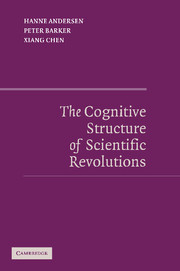Book contents
- Frontmatter
- Contents
- List of Figures
- Acknowledgments
- The Cognitive Structure of Scientific Revolutions
- 1 Revolutions in Science and Science Studies
- 2 Kuhn's Theory of Concepts
- 3 Representing Concepts by Means of Dynamic Frames
- 4 Scientific Change
- 5 Incommensurability
- 6 The Copernican Revolution
- 7 Realism, History, and Cognitive Studies of Science
- References
- Index
2 - Kuhn's Theory of Concepts
Published online by Cambridge University Press: 18 July 2009
- Frontmatter
- Contents
- List of Figures
- Acknowledgments
- The Cognitive Structure of Scientific Revolutions
- 1 Revolutions in Science and Science Studies
- 2 Kuhn's Theory of Concepts
- 3 Representing Concepts by Means of Dynamic Frames
- 4 Scientific Change
- 5 Incommensurability
- 6 The Copernican Revolution
- 7 Realism, History, and Cognitive Studies of Science
- References
- Index
Summary
After the appearance of The Structure of Scientific Revolutions in 1962 Kuhn attempted to develop a Wittgensteinian account of family resemblance concepts for a domain that other philosophers had found most unlikely: scientific concepts. In the 1970 postscript to Structure Kuhn even suggested that the variants of Newton's second law that applied to different physical systems showed family resemblance, but no single defining properties. If this proved to be the general case, the most important examples of scientific concepts might turn out to be family resemblance concepts rather than the well-behaved concepts, analyzable by necessary and sufficient conditions, expected by earlier philosophers of science. Kuhn returned to these themes again and again in his later philosophical writings.
Kuhn's theory of concepts focused on a restricted class of terms, namely, kind terms. As Kuhn defined kind terms they are “primarily the count nouns together with the mass nouns, words which combine with count nouns in phrases that take the indefinite article. Some terms require still further tests hinging, for example, on permissible suffices” (Kuhn 1991: 92). Thus, kind terms include natural kinds, artifactual kinds, and social kinds.
EXEMPLARS
An important source for Kuhn's theory of concepts was his early reflection upon science teaching. He made the observations that, first, science education is based entirely on prepared teaching materials, and, second, this teaching confers the ability to recognize resemblances between novel problems and problems that have been solved before.
- Type
- Chapter
- Information
- The Cognitive Structure of Scientific Revolutions , pp. 19 - 41Publisher: Cambridge University PressPrint publication year: 2006

